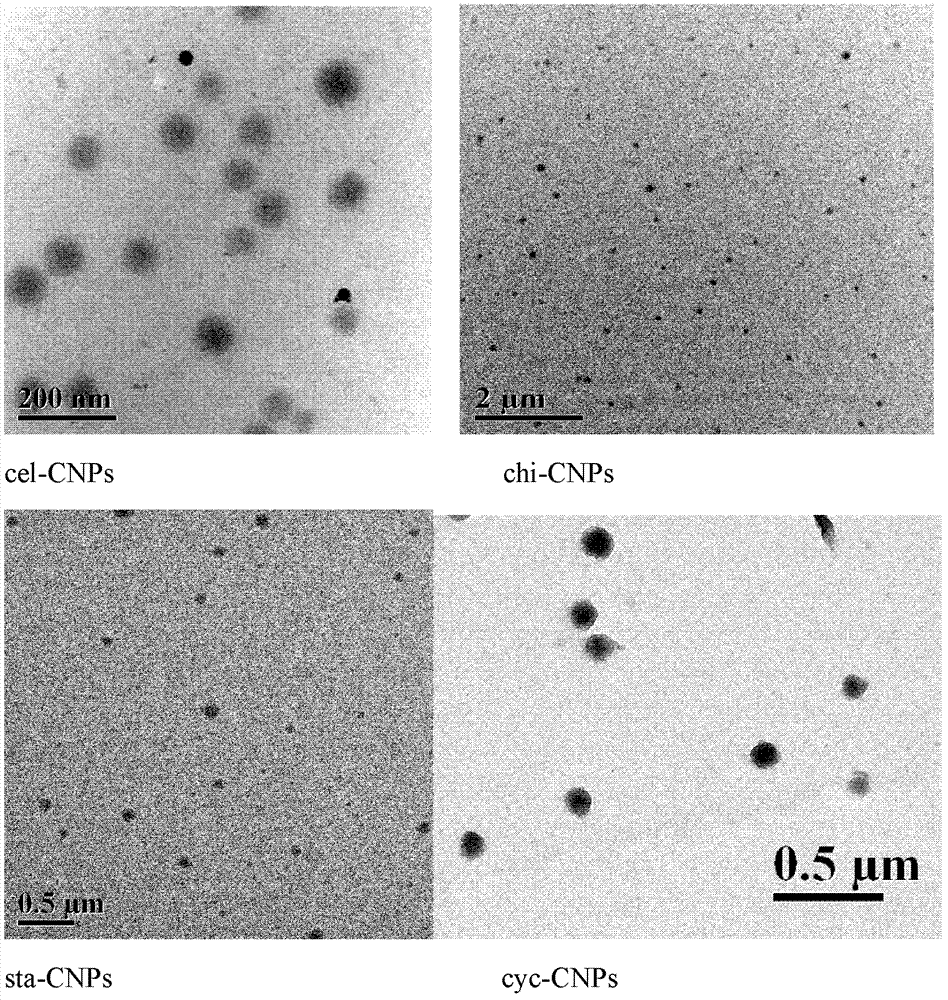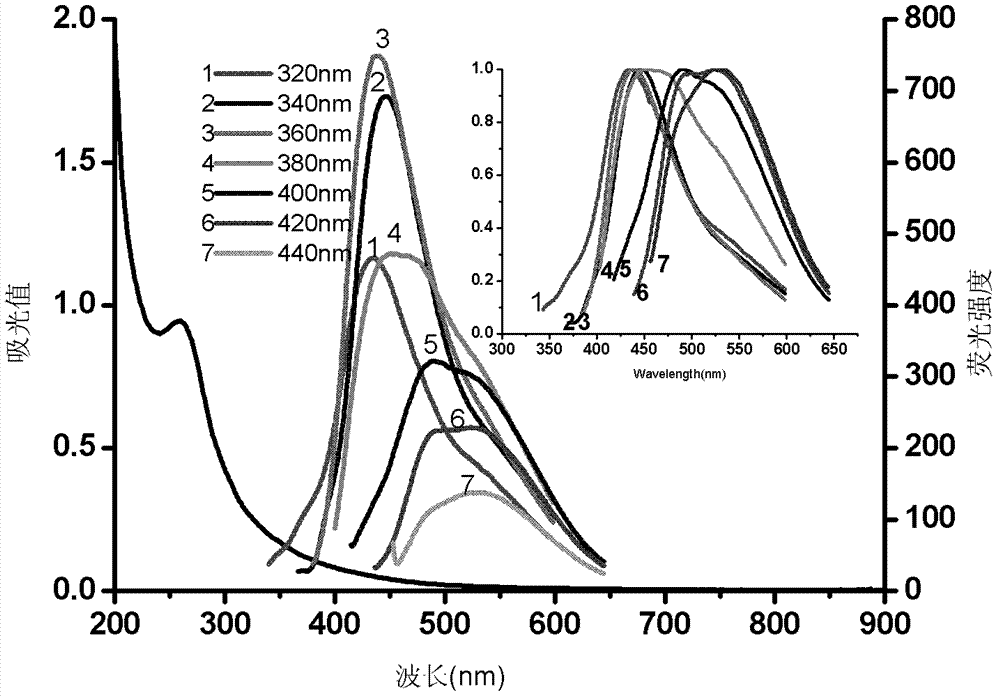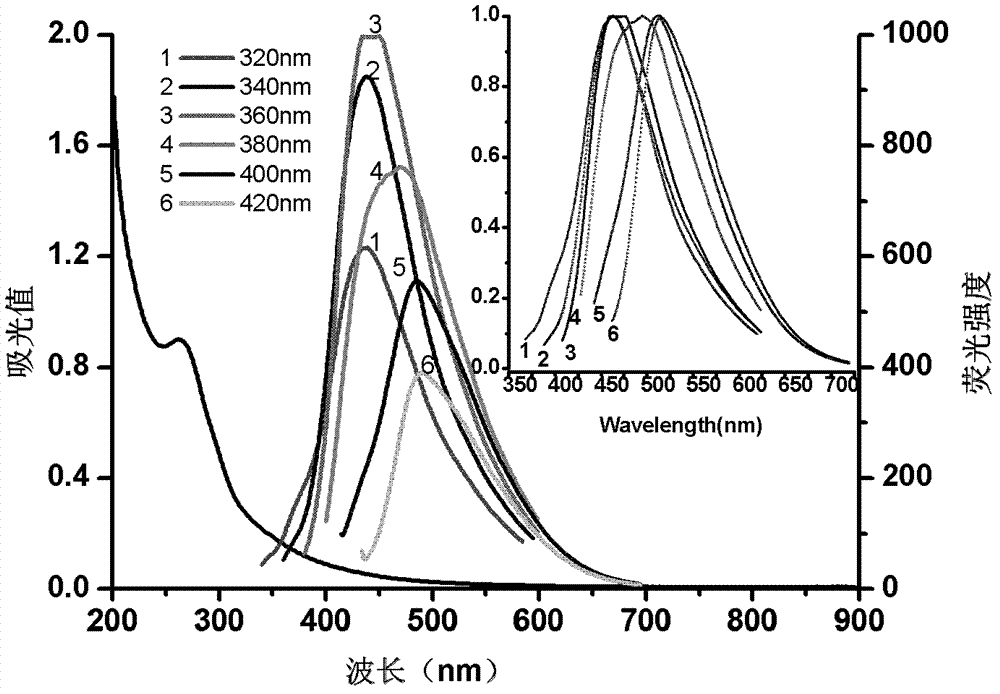Functional fluorescence carbon nanoparticles based on natural saccharide materials and preparation method and application thereof
A carbon nanoparticle and nanoparticle technology, applied in the field of nano-fluorescent materials, can solve the problems of complex preparation process, not extensive enough, and difficult separation of carbon nanoparticle, and achieve the effect of simplifying complex synthesis process, expanding selection range, and good dispersibility.
- Summary
- Abstract
- Description
- Claims
- Application Information
AI Technical Summary
Problems solved by technology
Method used
Image
Examples
Embodiment 1
[0030] Example 1: Preparation and separation and purification of carbon nanoparticles
[0031] (1) Preparation of cel-CNPs, chi-CNPs, sta-CNPs, cyc-CNPs carbon nanoparticles
[0032] Weigh 1 g of starch (cellulose, chitosan or cyclodextrin) and 0.1 g of NaOH respectively in a beaker, and add 15 ml of deionized water. Then the reactants were placed in an autoclave for 4 hours at a temperature of 160 degrees. After cooling to room temperature, the pH of the reaction product was adjusted to 7 with 1M HCl.
[0033] (2) Separation and purification of cel-CNPs, chi-CNPs, sta-CNPs, cyc-CNPs carbon nanoparticles:
[0034] Use a centrifuge to remove impurities from the obtained product solution, first use 4000rmp to remove larger impurity molecules in the product solution, and then use mixed cellulose material with 0.8μm, 0.45μm, and 0.22μm microfiltration membranes to remove relatively small impurities. of impurities. Then the obtained sample solution was treated with a dialysis b...
Embodiment 2
[0035] Example 2: Characterization of Carbon Nanoparticle Properties
[0036] (1) TEM characterization of carbon nanoparticles
[0037] Depend on figure 1 It can be seen that the particle size of cel-CNPs is about 150nm, the particle size of chi-CNPs is about 100nm, and the particle size distribution is relatively uniform, and the monodispersity is better; the particle size of sta-CNPs and cyc-CNPs is about 100-200nm , the particle size distribution is wider, but the monodispersity is better.
[0038] (2) UV absorption spectrum and fluorescence spectrum of carbon nanoparticles
[0039] figure 2 , image 3 , Figure 4 and Figure 5 The UV absorption spectra and fluorescence spectra of cel-CNPs, chi-CNPs, sta-CNPs, and cyc-CNPs are shown respectively. It can be seen from the figure that the four carbon nanoparticles have similar absorption peaks at 250-300nm. It is a typical peak of C=C. Under the action of excitation light of different wavelengths (300nm-500nm), the fou...
Embodiment 3
[0044] Example 3: Microwave treatment improves the fluorescence quantum yield of carbon nanoparticles
[0045] (1) Microwave treatment method
[0046] Take a certain amount of carbon nanoparticles (sta-CNPs, cel-CNPs, chi-CNPs, cyc-CNPs), add deionized water to 50ml, then put it in the center of the microwave oven, heat it at 800W for 5 minutes, and set it with ultrapure water after cooling. to its original volume.
[0047] (2) Fluorescence quantum yields of four carbon nanoparticles after microwave treatment
[0048] Table 1 shows the fluorescence quantum yields of four kinds of carbon nanoparticles before and after microwave. The quantum yields of carbon nanoparticles with different carbon sources are different, and the quantum yields of nanoparticles obtained with starch as carbon source are higher. In addition, the quantum yields of nanoparticles obtained from the same carbon source are also significantly different under different excitation light. Using cellulose and c...
PUM
| Property | Measurement | Unit |
|---|---|---|
| particle diameter | aaaaa | aaaaa |
| particle diameter | aaaaa | aaaaa |
| particle diameter | aaaaa | aaaaa |
Abstract
Description
Claims
Application Information
 Login to View More
Login to View More - R&D
- Intellectual Property
- Life Sciences
- Materials
- Tech Scout
- Unparalleled Data Quality
- Higher Quality Content
- 60% Fewer Hallucinations
Browse by: Latest US Patents, China's latest patents, Technical Efficacy Thesaurus, Application Domain, Technology Topic, Popular Technical Reports.
© 2025 PatSnap. All rights reserved.Legal|Privacy policy|Modern Slavery Act Transparency Statement|Sitemap|About US| Contact US: help@patsnap.com



